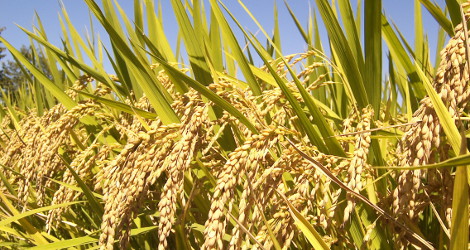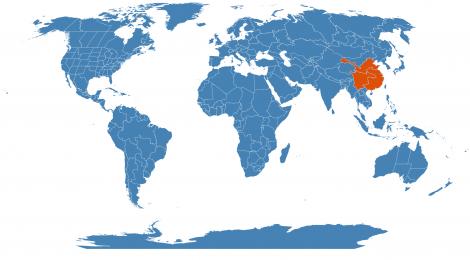Accession Data:
Oryza sativa L.
- Common Name: Asian Rice cv. Taipei 309
- Family: Poaceae Barnh.
- Description: Rice is a member of the grass family with an average height of 3 feet. Each stalk ends with a panicle holding grains. The rice stem contains air chambers that allow air to diffuse from leaves to the waterlogged roots. Rice is cultivated in flooded fields or paddies. Rice is greatly aided by a small aquatic fern, Azolla that has a symbiotic relationship with nitrogen-fixing alga. Rice farmers have found that growing this fern with their rice plants increases the amount of nitrogen available to the plants. Azolla is used as a green compost.
- Uses: Rice feeds more people worldwide than any other crop.
- USDA Zone: 8a-11?
Accession Data:
- Accession # 200500010
- Source: Jane Knapp
- Accession Date: 02-08-2005
- Bench: 1216 - AUS:Ground Bed 2 SW
- Currently: active - healthy
- Qty: 2 confirmed on 12-11-2024
Classification:
- Division: Magnoliophyta
- Class: Liliopsida
- SubClass: commelinids
- Order: Poales
- SubOrder:
- Family: Poaceae
- SubFamily: Oryzoideae
- Tribe: Oryzeae
- SubTribe: Oryzinae
Flowering Data:
This accession has been observed in bloom on:| Year | Jan | Feb | Mar | Apr | May | Jun | Jul | Aug | Sep | Oct | Nov | Dec | ||||||||||||||||||||||||||||||||||||||||
|---|---|---|---|---|---|---|---|---|---|---|---|---|---|---|---|---|---|---|---|---|---|---|---|---|---|---|---|---|---|---|---|---|---|---|---|---|---|---|---|---|---|---|---|---|---|---|---|---|---|---|---|---|
| 2025 | ||||||||||||||||||||||||||||||||||||||||||||||||||||
| 2024 | ||||||||||||||||||||||||||||||||||||||||||||||||||||
| 2023 | ||||||||||||||||||||||||||||||||||||||||||||||||||||
| 2022 | ||||||||||||||||||||||||||||||||||||||||||||||||||||
| 2021 | ||||||||||||||||||||||||||||||||||||||||||||||||||||
| 2020 | ||||||||||||||||||||||||||||||||||||||||||||||||||||
| 2019 | ||||||||||||||||||||||||||||||||||||||||||||||||||||
| 2018 | ||||||||||||||||||||||||||||||||||||||||||||||||||||
| 2017 | ||||||||||||||||||||||||||||||||||||||||||||||||||||
| 2016 | ||||||||||||||||||||||||||||||||||||||||||||||||||||
| 2015 | ||||||||||||||||||||||||||||||||||||||||||||||||||||
| 2014 | ||||||||||||||||||||||||||||||||||||||||||||||||||||
| 2013 | ||||||||||||||||||||||||||||||||||||||||||||||||||||
| 2012 | ||||||||||||||||||||||||||||||||||||||||||||||||||||
| 2011 | ||||||||||||||||||||||||||||||||||||||||||||||||||||
| 2010 | ||||||||||||||||||||||||||||||||||||||||||||||||||||
| 2009 | ||||||||||||||||||||||||||||||||||||||||||||||||||||
| 2008 | ||||||||||||||||||||||||||||||||||||||||||||||||||||
| 2007 | ||||||||||||||||||||||||||||||||||||||||||||||||||||
| 2006 | ||||||||||||||||||||||||||||||||||||||||||||||||||||
References (internal):
- Aquatic Plants
- Wind Pollination (anemophily)
- Benthophyte
- Type Species
- EEB 3271 - Systematic Botany
- Edible Plants
- Edible Grains
- Domesticated Plants of Austronesia
- EEB Greenhouse Holdings native to: China South-Central / China North-Central / China Southeast /
References (external):
- Plants and Society by Estelle Levetin and Karen McMahon
- WCSP (2015). World Checklist of Selected Plant Families. Facilitated by the Royal Botanic Gardens, Kew. Accessed 17 February 2015
- Oryza sativa at Wikispecies. Accessed 29 July 2015.
- Images #00 (cropped) and #01 (original) bBy IRRI Images (originally posted to Flickr as Korea_0001) [CC BY 2.0], via Wikimedia Commons
data regenerated on Fri, 14 Mar 2025 11:30:04 -0400 [bcm v4.0]
Images:

Additional images for this accession:
Click on thumbnails to enlargeCurrent Accessions in the Poaceae
Subfamily Bambusoideae
Tribe Arundinarieae
Subfamily Bambusoideae
Tribe Bambuseae
Subfamily Bambusoideae
Tribe Olyreae
- Parianinae: Eremitis sp.

Subfamily Chloridoideae
Tribe Zoysieae
- Sporobolinae: Spartina bakeri


Subfamily Oryzoideae
Tribe Oryzeae
- Oryzinae: Oryza glaberrima

- Oryzinae: Oryza sativa


Subfamily Panicoideae
Tribe Andropogoneae
- Andropogoninae: Cymbopogon citratus


- Andropogoninae: Schizachyrium scoparium

Subfamily Panicoideae
Tribe Paniceae
- Boivinellinae: Oplismenus hirtellus 'Variegatus'

- Cenchrinae: Stenotaphrum secundatum


- Panicinae: Panicum sphaerocarpon


Subfamily Panicoideae
Tribe Sacchareae
- Coicinae: Coix lacryma-jobi

- Saccharinae: Miscanthus sinensis 'Zebrinus'
- Saccharinae: Pogonatherum crinitum

- Saccharinae: Saccharum officinarum


- Tripsacinae: Zea mexicana


 = indicates flowering in past 14 days
= indicates flowering in past 14 days
 = images available for this accession
= images available for this accession
 = map available for this accession
= map available for this accession
 = accession added within past 90 days
= accession added within past 90 days

